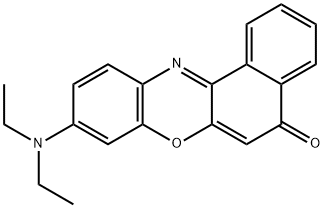| Identification | More | [Name]
NILE RED | [CAS]
7385-67-3 | [Synonyms]
9-(DIETHYLAMINO)-5H-BENZO[A]PHENOXAZIN-5-ONE
NILE BLUE A OXAZONE
NILE RED
9-(diethylamino)-5h-benzo[a]phenoxazin-5-on
nile
9-(diethylamino)benzo[a]phenoxazin-5(5H)-one
FLUORESCENCE QY-STANDARD E CERTIFIED
Fluorescent Spectral Standard E, certified
9-(Diethylamino)benzo[a]phenoxazin-5(5H)-on
Nile Red, pure, 99%
9-Diethylamino-benzo[a]phenoxazin-5-one
7-(Diethylamino)-1,2-[1,3]butadieno-3H-phenoxazine-3-one
9-Diethylamino-5H-benzo[a]phenoxazine-5-one
Oxazine O-17M
Phenoxazone | [EINECS(EC#)]
230-966-0 | [Molecular Formula]
C20H18N2O2 | [MDL Number]
MFCD00011639 | [Molecular Weight]
318.37 | [MOL File]
7385-67-3.mol |
| Chemical Properties | Back Directory | [Appearance]
solid | [Melting point ]
203-205 °C(lit.)
| [Boiling point ]
457.53°C (rough estimate) | [density ]
1.1871 (rough estimate) | [refractive index ]
1.5700 (estimate) | [storage temp. ]
room temp | [solubility ]
methanol: soluble1mg/mL | [form ]
Powder | [pka]
4.08±0.20(Predicted) | [color ]
Dark red to maroon | [Stability:]
Stable. Incompatible with strong oxidizing agents. | [λmax]
553 nm | [BRN ]
279110 | [InChI]
InChI=1S/C20H18N2O2/c1-3-22(4-2)13-9-10-16-18(11-13)24-19-12-17(23)14-7-5-6-8-15(14)20(19)21-16/h5-12H,3-4H2,1-2H3 | [InChIKey]
VOFUROIFQGPCGE-UHFFFAOYSA-N | [SMILES]
C12=CC=CC=C1C(=O)C=C1C2=NC2=C(C=C(N(CC)CC)C=C2)O1 | [CAS DataBase Reference]
7385-67-3(CAS DataBase Reference) | [EPA Substance Registry System]
5H-Benzo[a]phenoxazin-5-one, 9-(diethylamino)- (7385-67-3) |
| Hazard Information | Back Directory | [Description]
Nile red is a dye based on the benzo[a]phenoxazine core. Nile Red (9-diethylbenzo[a]phenoxazin-5- one) stands out as electrically neutral and water-insoluble since it features a carbonyl group at the 5-position that readily accepts the electron density. This makes it a strong push?pull chromophore, which underlies its distinct solvatochromicity and ability to indicate, e.g., cellular events in live-cell imaging. In addition, Nile Red’s inherent lipophilicity, near-infrared (NIR) emission, large Stokes shift, two-photon absorptivity (2PA), and low background fluorescence (as the luminosity is quenched in aqueous (aq) media) render it a near-ideal histochemical stain for studying membranes and lipid droplets in cells. The increase of its exquisite solvent sensitivity and steep emission in hydrophobic environments has also been employed in various forms of stochastic super-resolution localization microscopy[1].
| [Chemical Properties]
solid | [Uses]
A photostable, lipophilic stain with bright red fluorescence | [Uses]
Nile red is a lipophilic stain. Nile red stains intracellular lipid droplets. Nile red is also intensely fluorescent, with a strong yellow-gold emission if included into a lipid-rich environment. | [Definition]
ChEBI: An organic heterotetracyclic compound that is 5H-benzo[a]phenoxazin-5-one substituted at position 9 by a diethylamino group. | [General Description]
Nile Red is an uncharged hydrophobic molecule and a benzophenoxazone dye. It functions as a fluorescent probe for intracellular lipids and hydrophobic domains of proteins. This dye is fluorescent in all organic solvents. Its fluorescence colors range from golden yellow to deep red. | [Synthesis]
Using the 1,3-Naphthalenediol Approach to synthsis Nile red. To a solution of 1,3-naphthalenediol (0.50 g, 3.12 mmol) in anhydrous DMF (25 mL) was added 4-nitroso-N,N-diethylaniline (0.56 g, 3.12 mmol). This reaction mixture was stirred at 80 °C (DrySyn heating block) for 16 h and concentrated under reduced pressure. The crude product was purified by flash chromatography (0?50% EtOAc in hexanes) to obtain Nile Red, which crystallized from hexanes in green crystals (0.80 g, 2.50 mmol). Yield: 80%[1].
| [storage]
Room temperature | [References]
[1] Mick Hornum*. “Substituted 9-Diethylaminobenzo[a]phenoxazin-5-ones (Nile Red Analogues): Synthesis and Photophysical Properties.” The Journal of Organic Chemistry 86 2 (2020): 1471–1488.
|
|
|





